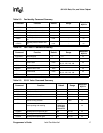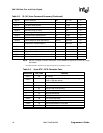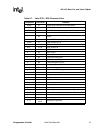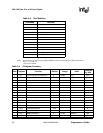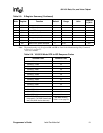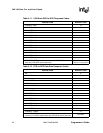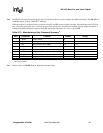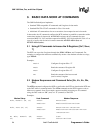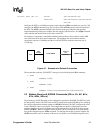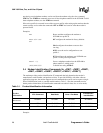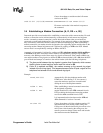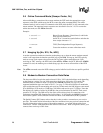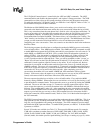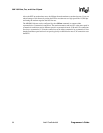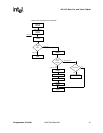
56K V.92 Data, Fax, and Voice Chipset
24 Intel Confidential Programmer’s Guide
3. BASIC DATA MODE AT COMMANDS
The 56K FastPath chipsets implement:
• Standard TIES-compatible AT commands and S-registers in data mode
• Standard EIA/TIA-578 AT commands in Class 1 fax mode
• Additional AT command sets for error correction, data compression and voice mode
In data mode, the AT commands configure the DCE (modem) to establish a connection with a
remote data modem. In data mode, the MD566X executes the AT commands for error
correction (MNP 2-4, V.42) and data compression (MNP 5, V.42 bis) described in Table 4-2 on
page 66, as well as the fax and voice mode commands AT+FCLASS=1 (fax) and
AT+FCLASS=8 (voice).
3.1 Using AT Commands to Access the S-Registers [Sn?, Sn=x,
?]
The DTE can access the S-registers through the ATSn?, ATSn=x, and ? commands. For
example, to configure the modem to automatically answer a data modem call after two rings,
type ATS0=2.
Examples:
ATS0=2 Configures S-register S0 to “2”
ATS0? Reads the contents of S-register S0
ATS0= Configures S-register S0 to “0”
AT? Reads the contents of the last accessed
(read or write) S-register
3.2 Modem Responses and Command Echo [En, Vn, Xn, Wn,
Qn]
The ATEn command configures the DCE to send back to the DTE any data that the DTE sent
to the DCE while in command mode. The ATVn command sets the DCE response codes to
either text or numeric form. For example, upon successfully processing an AT command
string, the DCE sends an “OK” (text) or a “0” (numeric) to the DTE.
Examples:
Modem Setup Host Command Modem Response
Echo, Numeric (E1, V0) AT<CR> AT<CR>0<CR>
ATS0?<CR> ATS0?<CR>000<CR><LF>0<CR>
Echo, Text (E1, V1) AT<CR> AT<CR><CR><LF> OK<CR><LF>
ATS0?<CR> ATS0?<CR><CR><LF>000<CR><LF><CR>
<LF>OK<CR><LF>
No Echo, Numeric (E0,
V0)
AT<CR> 0<CR>
ATS0?<CR> 000<CR><LF>0<CR>




